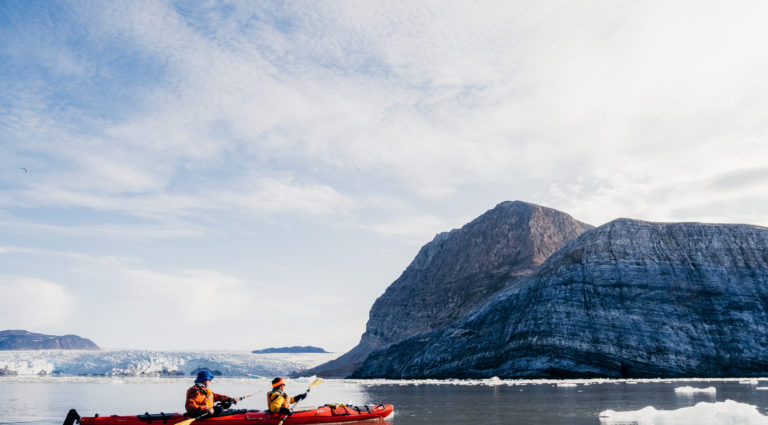Northern Isles & Wilderness: Scotland & Iceland
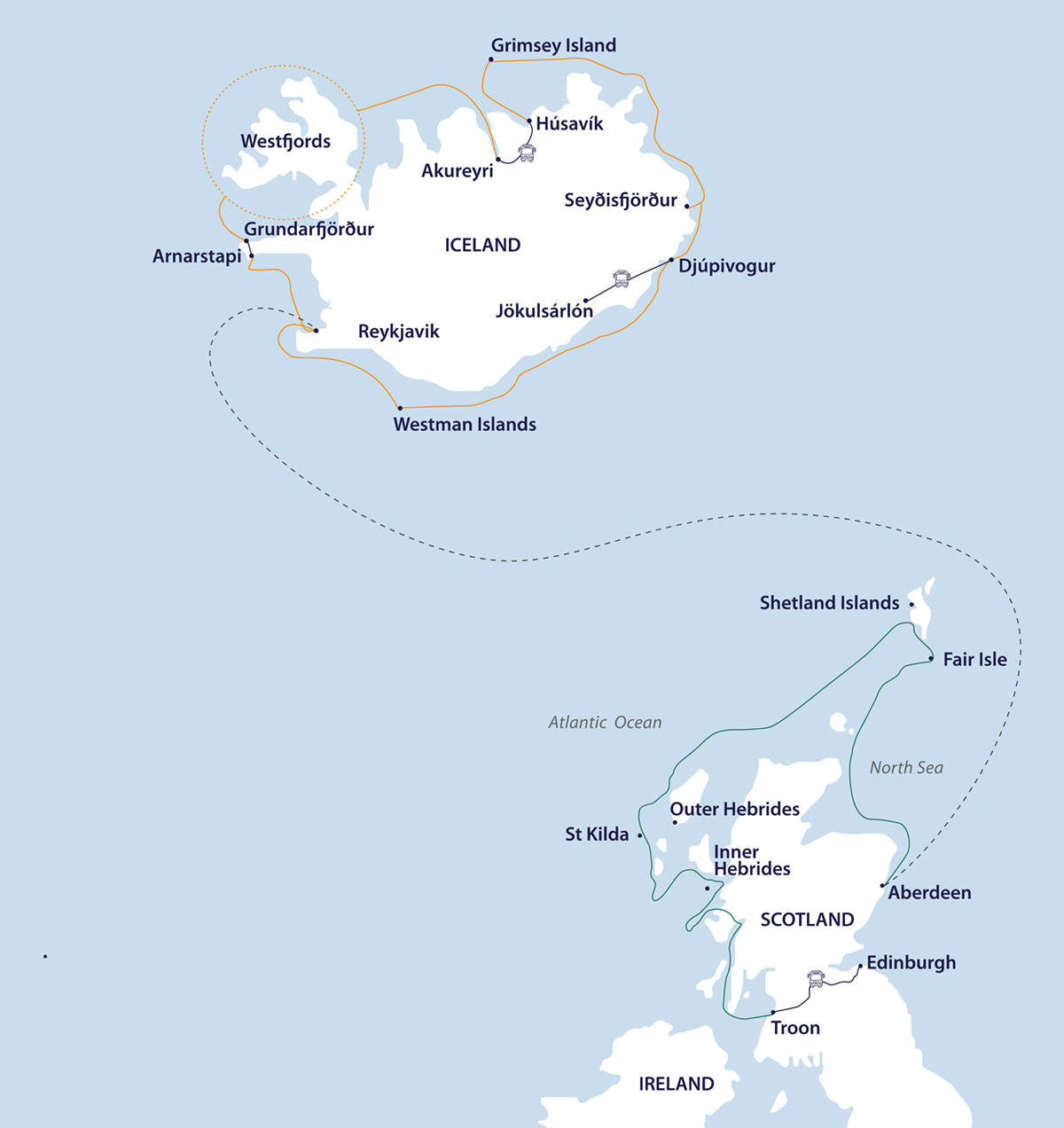
A combination of ‘Wild Scotland’ + ‘Iceland: Encircling the Land of Fire and Ice’
Departure Date: 18 May 2025 – 12 Jun 2025 | 26 days
Departure/Arrival: Edinburgh, Scotland – Reykjavik, Iceland
Voyage code: SCI001G
Voyage type: Discovery
Ship: Greg Mortimer
Price: from AUD $35,595 (Aurora Stateroom Twin)
Call us on 1800 637 688 for full pricing and special offers!
Summary
Thank you for joining Aurora Expeditions on our Northern Isles: Scotland & Iceland combination voyage.
Combining our Wild Scotland and Iceland: Encircling the Land of Fire and Ice voyages, you’ll experience the lush verdant scenery of Scotland’s far-flung islands and learn of life in pre-Christian times, before sailing north to Iceland to hear sagas of Viking history and witness remarkable landscapes formed by volcanic activity.
Highlights
- Visit Britain’s highest sea cliffs at St Kilda – a UNESCO World Heritage Site
- Keep watch for otters, dolphins, basking sharks, and Atlantic puffins nesting in burrows in sea cliffs
- Witness the incredible diversity of Iceland’s landscapes forged by the powerful seismic activity that has shaped the island’s appearance and way of life of the people
- Explore the Shetland Islands and learn about its fascinating history
Gallery
In true expedition style we encourage exploration and adventure, offering flexibility in challenging environments in a way that puts you among the action to see and do as much as possible. This itinerary is only a guide and subject to change due to ice and weather conditions.
Itinerary
Having made your way to Edinburgh, you will be met by a representative of Aurora Expeditions and transferred to our group hotel. Upon arrival at your included hotel, please visit the Aurora Expeditions hospitality desk to collect your luggage cabin tags and to speak with our ground operations team, who may have information to share with you about pre-embarkation or to provide you with information about where to dine, withdraw cash or purchase last minute items from a local pharmacy or supermarket.
The remainder of your time is at leisure. All meals today are at your own expense.
Accommodation: Courtyard by Marriott Edinburgh Hotel (or similar)
After breakfast, check-out and bring your luggage to the foyer. Please place any items required today in your hand luggage as your main bag will be transferred to the ship.
Edinburgh awaits us this morning as our local guide welcomes us with stories of Scotland’s capital city. Stretching just over one mile, five cobblestoned streets make up the walking precinct of the Royal Mile. Starting at The Palace of Holyroodhouse, the official residence of the British monarch in Scotland, we’ll step back in time to hear tales of princes, poets, and politicians as we stroll past some of Edinburgh’s most iconic buildings including the Church of Canongate and Scotland’s own parliament house.
Perched atop an extinct volcano, Edinburgh Castle dominates the capital city’s skyline just as it has dominated Scotland’s long and colourful history. This instantly recognisable fortress is a powerful national symbol, and part of Edinburgh’s World Heritage Site. Your audio tour brings the castles inhabitants alive as you discover highlights such as the Royal Palace, the Crown Jewels, Mons Meg and the Scottish National War Memorial.
You’ll have time to explore the castle precinct and Royal Mile which are scattered with friendly pubs and charismatic restaurants (lunch own expense). Our two-hour transfer takes us to the west coast port of Troon where our expedition team will welcome you aboard the Greg Mortimer in the late afternoon.
Once onboard, settle into your cabin before our important briefings. We will set sail along Scotland’s northwest coast in the evening and meet your expedition team and crew.
From golden beaches to jagged peaks, bleak moors and heather clad hills; from abandoned settlements to picturesque villages, our days in the Hebrides archipelago will be packed with variety. We may explore remote lochs beneath some of Britain’s most untamed mountains and wander between unusual rock formations. We may watch for whales, dolphins, otters, seals, and the increasingly rare basking sharks. Possibly we will land at an island reserve that is home to red deer and white-tailed sea eagles.
Kayakers will be introduced to their craft and will be briefed for their adventures, before picking up paddles to circumnavigate tiny islets or glide into narrow waterways that intertwine the islands. Hikers may opt for panoramic views from summits and ridges.
Early the next morning we will aim for the tiny island of Iona. Barely 5 kilometres (3 miles) long, Iona is renowned as the birthplace of Christianity in Britain. It is also a burial ground of early Scottish Kings. The Irish monk, St Columba and twelve disciples, landed here and founded a monastery in 563 CE. From this base, St Columba set about converting Scotland and much of Northern England to Christianity.
We plan to land on remote Isle of Eigg and on the rugged Isle of Skye for wonderful hikes among stunning wildflowers. Skye is a centre of Gaelic culture, and some islanders still speak the language. The wildlife, history, geology and beautiful scenery make it one of our favourite islands to explore. We hope to make the following landings: The Cuillin Hills have earned a reputation as Britain’s most untamed and challenging mountains. The rocky jagged Black Cuillins attract rock climbers. The smoother conical granite peaks of the Red Cuillins are crowned with heather. We may land at Loch Scavaig in the heart of the Cuillins and take a short hike, perhaps to Loch Coruisk, for spectacular views and get a glimpse of the range’s grandeur. Keener hikers may be able to venture further afield, weather permitting. Meanwhile kayakers may paddle around Loch Scavaig, into Loch Coruisk. They may explore the island of Soay and an abandoned shark fishing station – all against the backdrop of classic views of the Cuillins.
To the south of the Cuillin hills we may visit Rubha’ an Dùnain, a small uninhabited peninsula on the southwest corner of Skye commanding an impressive view of the sea routes nearby. As a result of its strategic position, we can see archaeological remains—from a Neolithic chambered cairn to a Viking canal and more recent black houses. Depending on weather conditions, we may choose to visit the small island of Canna in search of the rare basking sharks, common seals and bird cliffs.
From the Inner Hebrides we make our way to the Outer Hebrides – also known as the Western Isles – that stretch for 209 kilometres (128 miles) and look out on their western side to the Atlantic Ocean. Our first stop is at the Isle of Lewis, the largest and northern-most island in the Outer Hebrides. We plan to make a stop at Callanais, where archaeology buffs will be keen to see the fascinating group of Standing Stones, dating from around 3,000 BCE.
Weather permitting, we plan to land at the isolated archipelago (and World Heritage site) of St Kilda, where derelict crofts bear testament to the fortitude of islanders who once tended the unique Soay sheep and harvested seabirds for food—and to pay their rent in the form of wool, meat and feathers. The isles hold Europe’s most important seabird colony and is home to Britain’s highest sea stacks (rock columns). Island hopping northeast, we aim to visit tiny specks of land that bear the brunt of violent Atlantic storms and rarely see visitors. Home to breeding seals and some of Europe’s largest seabird colonies, Sula Sgeir, North Rona and Flannan boast spectacular cliffs, fantastic rock stacks, hidden beaches and luxuriant heaths where sheep once grazed.
Britain’s most northerly islands lie almost 160 kilometres (99 miles) north of the Scottish mainland, at a similar latitude to the southern tip of Greenland, or Bergen in Norway. Kept relatively warm by the Gulf Stream, Shetland’s 100 islands experience almost 24 hours of daylight in summer. They abound with nature reserves and archaeological sites and offer a taste of traditional island life. We plan to explore some of the following sites:
The island of Foula is the most remote inhabited island in the UK. Its small community of about 30 residents welcome us to their island to enjoy the magnificent scenery, large seabird colonies, beautiful wildflowers and remarkable community life. Papa Stour offers some of the best sea caves in Britain where we may explore with Zodiacs and kayaks.
Hermaness National Nature Reserve, is close to Britain’s most northerly point. The reserve is a place of bird cries and sea smells, of myth and mist. The cliffs rise 170 metres (558 feet) above the Atlantic. During summer they are alive with the cacophony, and raw guano smell of over 100,000 breeding seabirds: kittiwakes, shags, snipe, dunlin, golden plover and Arctic skua, making this one of Europe’s most diverse colonies. The grasslands, moors and cliff tops are a tapestry of colourful wildflowers – gentians, heather, orchids and thrift are a few of the species here.
A rocky islet, Muckle Flugga is Britain’s most northerly point and only 274 kilometres (170 miles) from Norway. A lighthouse was established here in 1854, to protect navy ships during the Crimean War.
Midway between Orkney and Shetland, Fair Isle houses a major European ornithological research station, and is also famous for knitwear and historic shipwrecks. About five kilometres by three kilometres / three miles by two miles in area, it is surrounded by impressive cliffs. The 70 or so islanders mainly live in traditional crofts on the more fertile low-lying southern part of the island.
At the Knap of Howar on Papa Westray lies the earliest known house in Northern Europe, occupied by Neolithic farmers over 5,000 years ago. At the east end of Scapa Flow remnants from World War II include an Italian Chapel, created by Italian prisoners of war made out of two Nissen huts, and the Churchill Barriers, constructed on the orders of Winston Churchill to keep out U-Boats.
Discover the rich history in Kirkwall, capital of the Orkney Islands. Initial impressions are misleading, as the harbour area looks modern, but the narrow winding streets and lanes of the old town, which have remained relatively unchanged over the centuries are appealing.
As we sail the wild North Atlantic Ocean to Iceland, enjoy informative and entertaining talks and presentations from our knowledgeable expedition team, or stay active in the fitness centre before relaxing in the sauna. Our state-of-the-art vessel offers a choice of observation lounges and a well-stocked library for you to enjoy.
On arrival in Reykjavik, Iceland’s cosmopolitan capital, our crew and expedition team prepare to welcome expeditioners joining us on our Iceland: Encircling a Land of Fire and Ice voyage, while you enjoy a day trip to Iceland’s famous Golden Circle. In the late afternoon, reboard the vessel and meet your fellow expeditioners to begin the next part of your arctic adventure around Iceland.
Note: In order to experience some of the incredible scenery of Iceland, a number of the shore excursions on Iceland voyage requires coach travel away from the coast.
At Arnarstapi, our Zodiacs tender as ashore. Located on the Snaefellsnes Peninsula, this area features diverse landscapes characterised by lava fields, glistening fjords and home to Breidafjordur Bay which is rich in birdlife. The area is crowned by the magnificent, ice-capped Snæfellsjökull volcano, a 700,000-year-old dormant subglacial volcano, visible from Reykjavik on a clear day and immortalised in Jules Verne’s Journey to the Centre of the Earth. You can choose from a selection of shore excursion options that best suits your interests and level of fitness. Options include a bus tour to Mount Kirkjufell, one of the most famous mountains in Iceland, or a choice of hikes including a glacier hike at Snæfellsjökull Glacier.
Over the next two days, we explore the Westfjords region featuring outstanding landscapes with jaw-dropping views of dramatic fjords carved by ancient glaciers, sheer table mountains that plunge into the sea and pristine North Atlantic vegetation.
Picturesque Akureyri is Iceland’s second largest city outside the capital area and is blessed with a superb snow-capped mountain backdrop. Choose from a selection of shore excursions in Akureyri to best suit your interests and level of fitness. Choose to visit Godafoss Falls and soak at Myvatn Nature baths, an outdoor hot spring bathing complex surrounded by mountain views. Alternatively, explore both Godafoss and Dettifoss waterfalls, the Mývatn region and Krafla.
In the late afternoon, we reboard our vessel in Husavik, the whale watching capital of Iceland.
Located approximately 40 km (25 miles) off the mainland, Grímsey is a verdant grassy island, probably best known for its proximity to the Arctic Circle, which cuts across the island. Many people travel to Grímsey just to say they have stepped across the imaginary line. With a tiny population of approximately 100 inhabitants, it’s a fantastic place for Zodiac cruising, kayaking, and photographing seabirds such as guillemots, gulls and puffins.
Leaving Grímsey to return closer to the mainland, we spend time scanning the waters of Skjálfandi Bay around Húsavik, a town known as the Iceland’s ‘whale watching capital’, home to up to 24 different whale species, as well as dolphins and 30 variety of birds. The largest animal on earth, the blue whale, has also been spotted in Skjálfandi Bay, and if you are lucky, you might catch a glimpse of this magnificent creature as well as others, such as orcas, fin whales and pilot whales.
We spend some time exploring Seydisfjordur, a picturesque fishing village that is renowned for its charming collection of colourful wooden buildings located around the lagoon. Take a stroll around town and discover the timber houses that are remnants from when the Norwegians settled here and established the herring fishing facilities from 1870-1900. From the valley above the town, the river Fjardara tumbles down in beautiful cascades to the lagoon. There are a number of delightful hiking trails to explore, or alternatively, you can discover a flourishing cultural scene with an arts centre, the famous blue church that stages music concerts and the only two cinemas in the east of Iceland. Back in town, browse the stores where you will discover handicrafts by local artists and artisans – perfect as a souvenir or gift.
In Iceland’s east, we disembark in Djupivogur, our gateway to Vatnajokull National Park, home to Europe’s largest glacier. We drive to Jokulsarlon Glacier Lagoon, a glacial lagoon filled with floating icebergs that wash up on shore and stand gleaming on the nearby black-sand beach, dubbed Diamond beach. At Jokulsarlon, you can choose from a boat excursion on the lagoon, try a hike on the glacier or hike to a canyon, visiting a number of waterfalls along the way.
Located off Iceland’s south coast, the Westman Islands were formed by volcanic eruptions around 10,000 years ago. Sail past Surtsey Island, a UNESCO World Heritage site that emerged from the sea in 1963 and is one the youngest land masses on earth. Westman Islands are surrounded by 15 other uninhabited islands and around 30 rocks and skerries offering refuge for rich array of seabirds. Westman Islands are considered to have the largest Atlantic puffin colony in the world, and when sailing around the islands it is not uncommon to see puffins but also whales and seals.
Heimaey is the main island in the archipelago, and it has the population of around 4,200. Ashore on Heimaey, the only inhabited island in the archipelago, we see half-buried houses that remain from a violent 1973 eruption of Eldfell volcano, which you can hike up if you wish. Eruptions are a big part of the history of the Westman Island, where there are two volcanoes – one that erupted some 6,000 years ago, and Mount Eldfell that erupted in 1973, forcing all of the island’s inhabitants to evacuate for the mainland. Serendipitously, due to bad weather the day prior to the eruption, all the fishing boats remained in the harbour and were able to help transport the inhabitants of Heimaey to the mainland. You can learn more about the story of the eruption and the aftermath at the fascinating Eldheimar museum, which includes a display of a house that was buried in ash during the eruption.
During the early morning, we cruise into Reykjavik and disembark at approximately 8.00 am. Farewell your expedition team and fellow passengers as you continue your onward journey. Transfer to Keflavik airport or to your centrally located hotel.
Note: We do not recommend booking flights that depart prior to 12.00 pm on the day of disembarkation, as we may experience delays at the conclusion of the voyage.
Inclusions
- All transfers mentioned in the itinerary.
- One night’s hotel accommodation including breakfast, in Edinburgh on Day 1.
- Half-day tour in Edinburgh followed by a transfer to Troon, on Day 2.
- Onboard accommodation during voyage, including daily cabin service.
- All meals, snacks, tea and coffee during voyage.
- Beer, house wine and soft drinks with dinner.
- Captain’s Farewell reception including four-course dinner, house cocktails, house beer and wine, non-alcoholic beverages.
- All shore excursions and Zodiac cruises.
- Educational lectures and guiding services provided by Expedition Team.
- Complimentary access to onboard expedition doctor and medical clinic (initial consultation).
- One 3-in-1 waterproof, polar expedition jacket.
- Complimentary use of Muck Boots during the voyage (in Spitsbergen).
- Comprehensive pre-departure information.
- Port surcharges, permits and landing fees.
Exclusions
- International or domestic flights – unless specified in the itinerary.
- Transfers – unless specified in the itinerary.
- Airport arrival or departure taxes.
- Passport, visa, reciprocity and vaccination fees and charges.
- Travel insurance or emergency evacuation charges.
- Hotel accommodation and meals – unless specified in the itinerary.
- Optional excursions and optional activity surcharges.
- All items of a personal nature, including but not limited to alcoholic beverages and soft drinks (outside of dinner service), gratuities, laundry services, personal clothing, medical expenses, wi-fi, email or phone charges.
Note: A $15 USD per person per day gratuity for the crew is automatically added to your onboard account. It is at your discretion if you would like to remove the tip (or adjust the amount) when you settle your bill. It is not necessary to tip the expedition team members. This gratuity amount is included for suites as part of their ‘Suite Benefits’.
Activities
Included Activities
Bird watching
Lectures on wildlife, our environment, history and destinations
Near shore cruises
Photography
Polar plunge
Trips ashore
Walking & hiking
Whale and mammal spotting
Zodiac cruises
Add-on Activities
Sea Kayaking
Sea Kayaking One of the most exhilarating ways to experience Antarctica, the Arctic and beyond. Sea kayaking holidays in the …
Cabins & Prices
Browse our comfortable staterooms and suites below. Please contact us for best pricing and current availability.
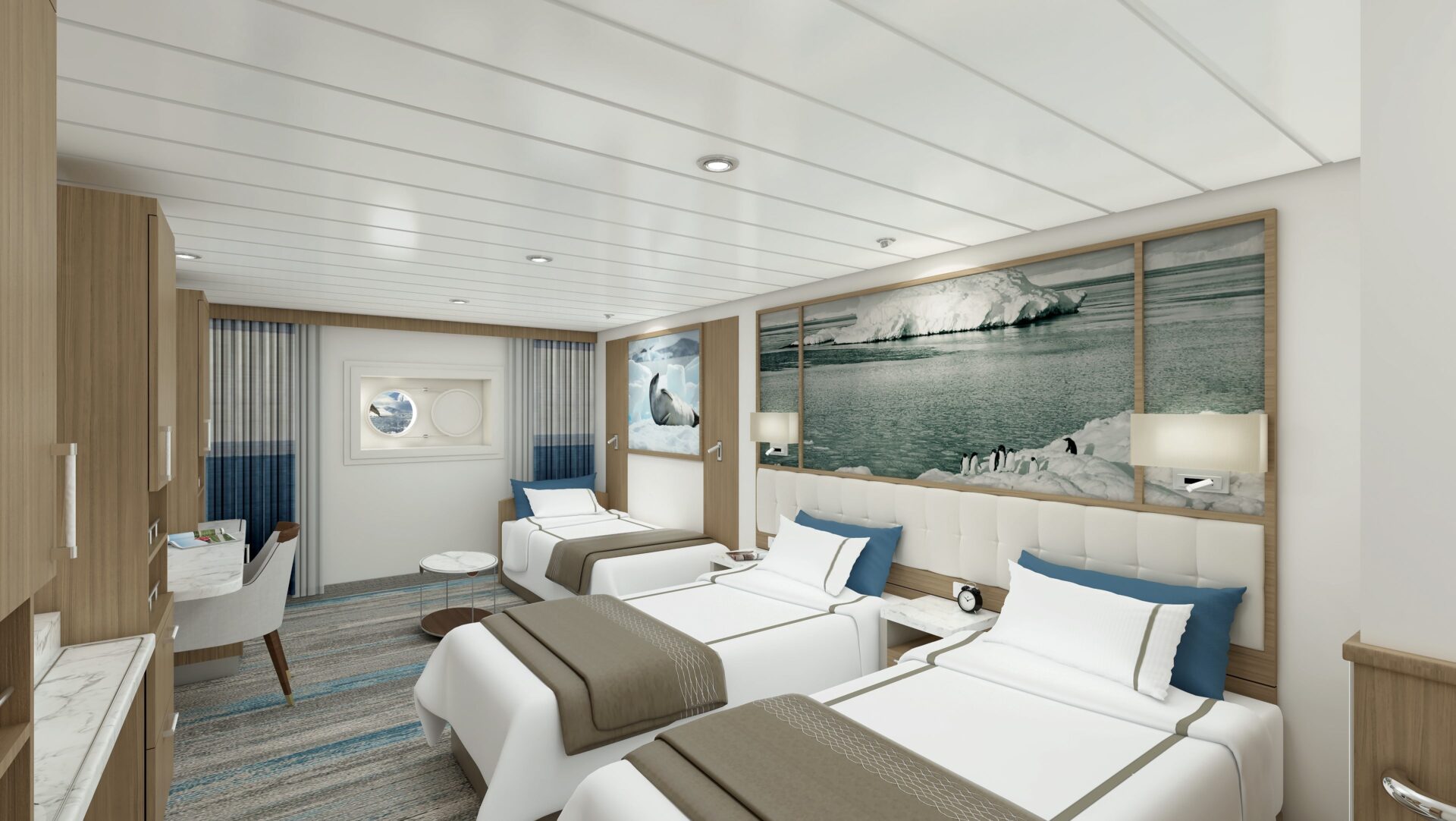
Aurora Stateroom Triple Share
Aurora Stateroom Triple Share
Deck: 3
Cabin size: 21.4m² - 22.8m² (230.34 ft² - 245.41 ft² )
King bed
Twin beds
Features
Private en-suite
Porthole window
Closet space
Room-controlled thermostat
Room safe
42" flat-screen TV
Desk area
Mini bar*
Cabin Inclusion
- 1 x 3-in-1 polar jacket per person (polar voyages only)
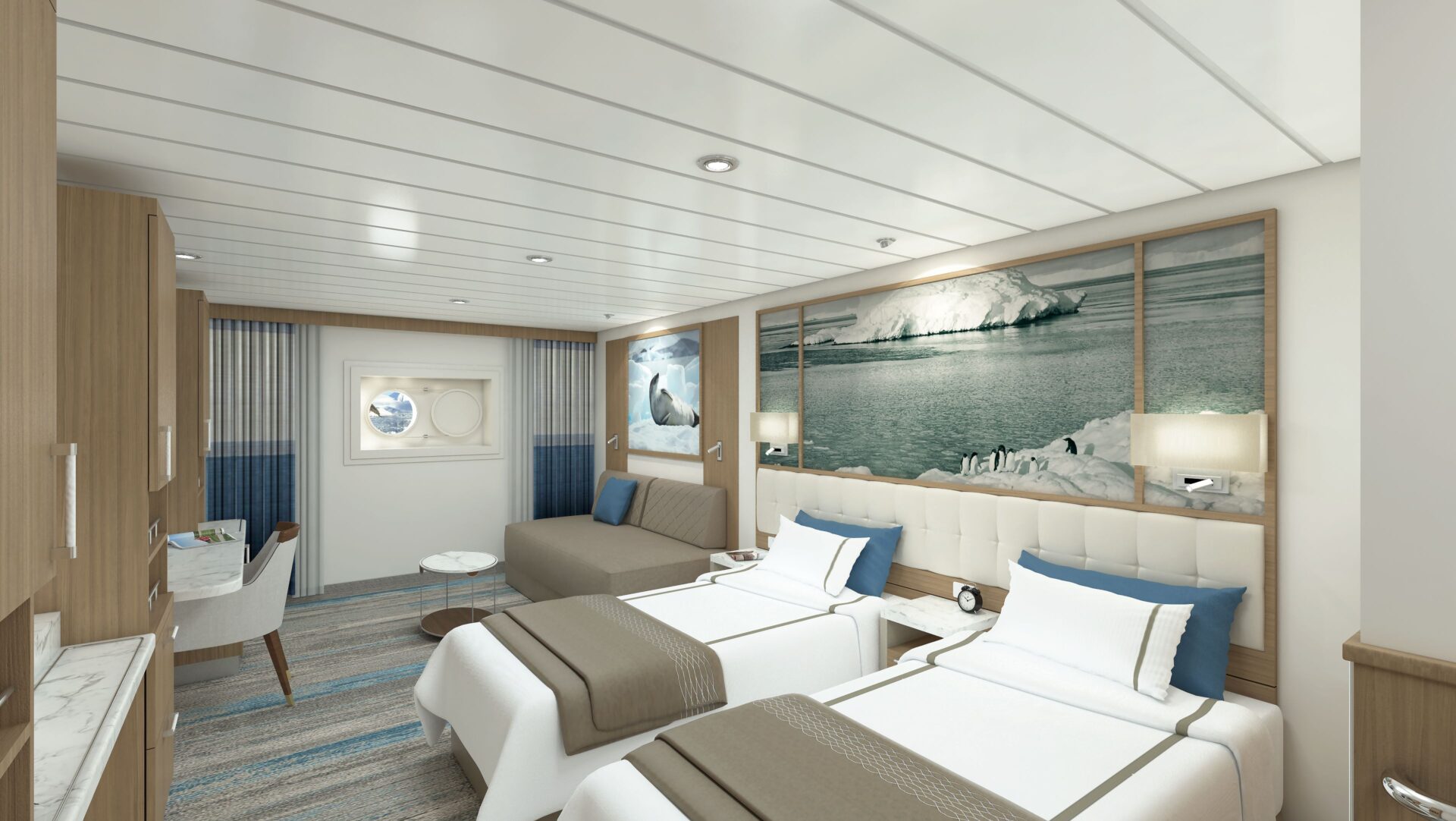
Aurora Stateroom Twin Share
Aurora Stateroom Twin Share
Deck: 3
Cabin size: 15.8m² - 22.8m² (170 ft² - 245.41 ft²)
King bed
Twin beds
Features
Private en-suite
Porthole window
Desk area
Closet space
Room-controlled thermostat
Room safe
42" flat-screen TV
Mini bar*
Cabin Inclusion
- 1 x 3-in-1 polar jacket per person (polar voyages only)
*Please note mini bar items are chargeable in all cabins except Junior Suite and Captain’s Suite
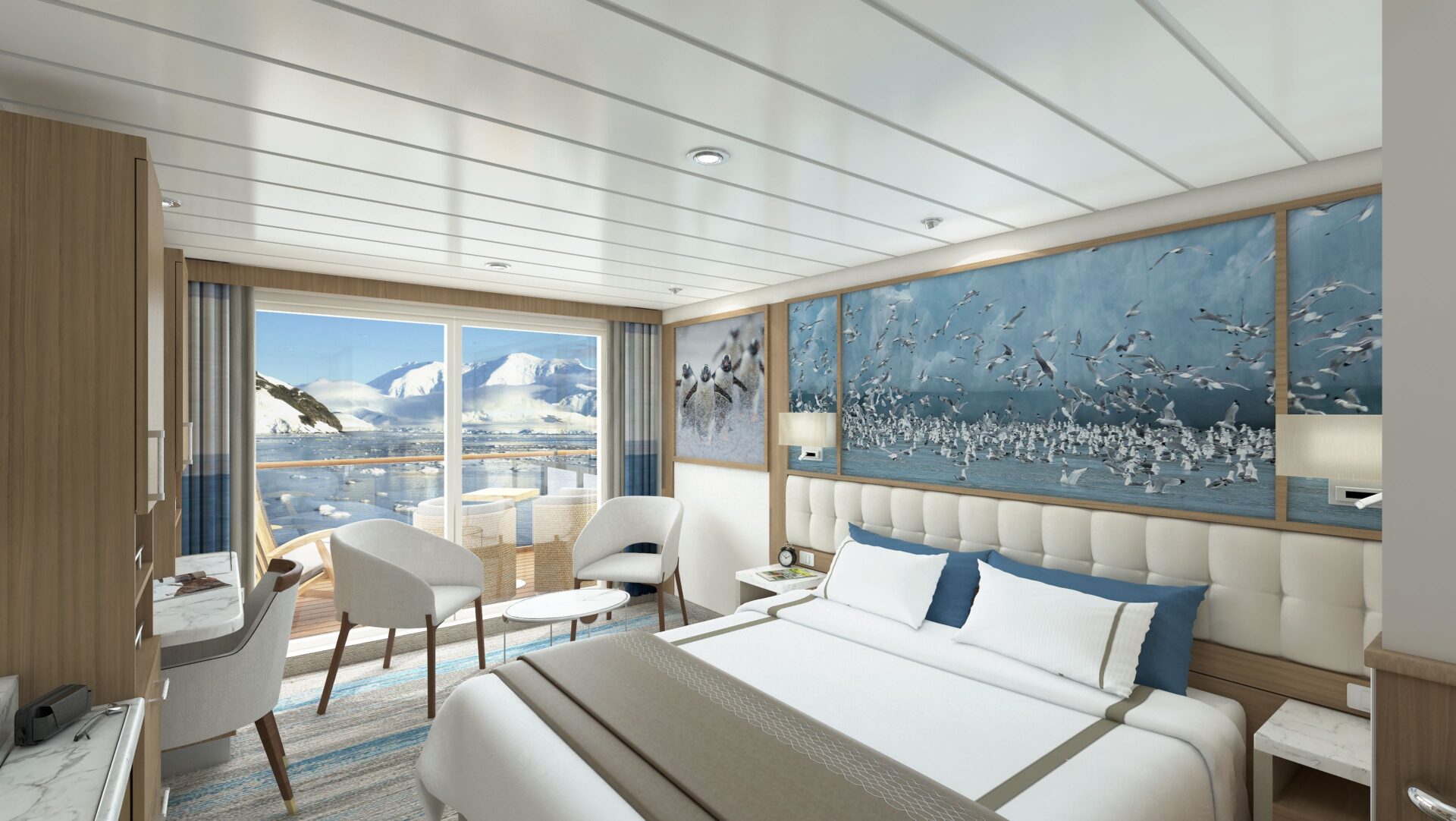
Balcony Stateroom Category C
Balcony Stateroom Category C
Deck: 4 & 6
Cabin and balcony combined size: 20.9m² - 24.8m² (224.97 ft² - 266.95 ft²)
King bed
Twin beds
Features
Private en-suite
Private balcony
Full size window
Desk area
Closet space
Room-controlled thermostat
Room safe
42" flat-screen TV
Mini bar*
Cabin Inclusion
- 1 x 3-in-1 polar jacket per person (polar voyages only)
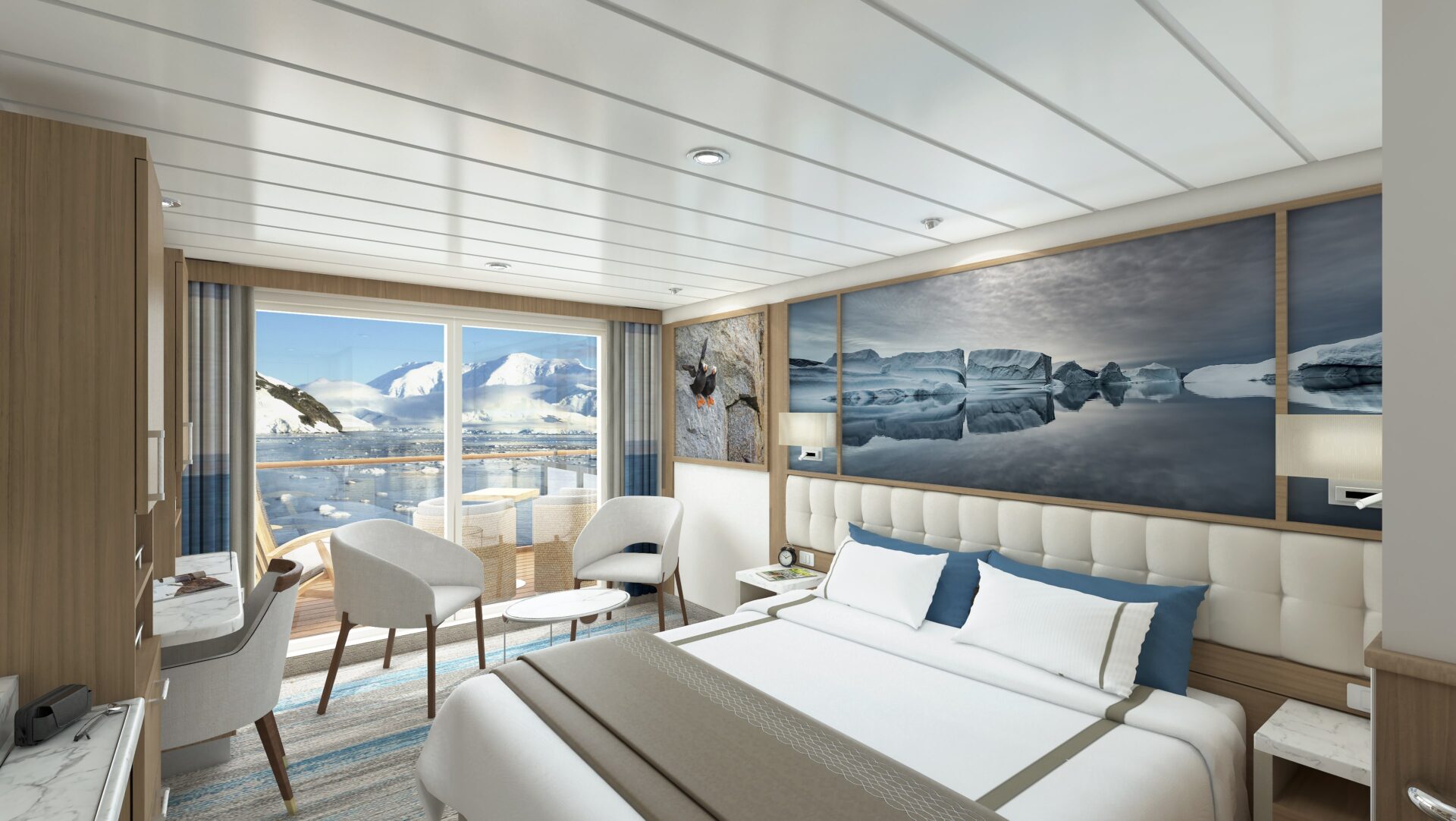
Balcony Stateroom Category B
Balcony Stateroom Category B
Deck: 4 & 6
Cabin and balcony combined size: 23.6m² - 24.8m² (254.03 ft² - 266.95 ft²)
King bed
Twin beds
Features
Private en-suite
Private balcony
Full size window
Desk area
Closet space
Room-controlled thermostat
Room safe
42" flat-screen TV
Mini bar*
Cabin Inclusion
- 1 x 3-in-1 polar jacket per person (polar voyages only)
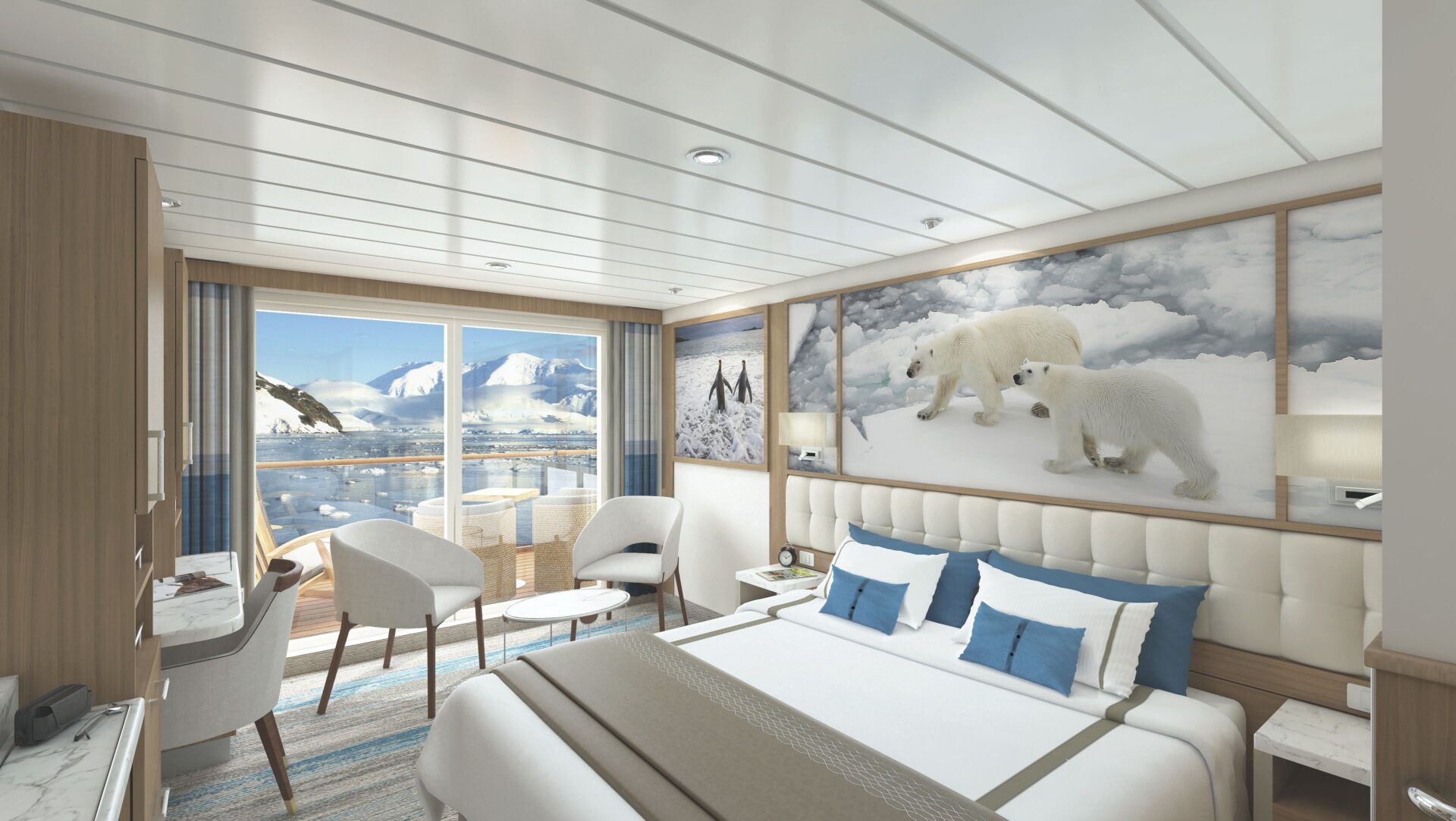
Balcony Stateroom Category A
Balcony Stateroom Category A
Deck: 4 & 6
Cabin and balcony combined size: 24.1m² - 28m² (259.41 ft² - 301.39 ft²)
King bed
Twin beds
Features
Private en-suite
Private balcony
Full size window
Desk area
Closet space
Room-controlled thermostat
Room safe
42" flat-screen TV
Mini bar*
Cabin Inclusion
- 1 x 3-in-1 polar jacket per person (polar voyages only)
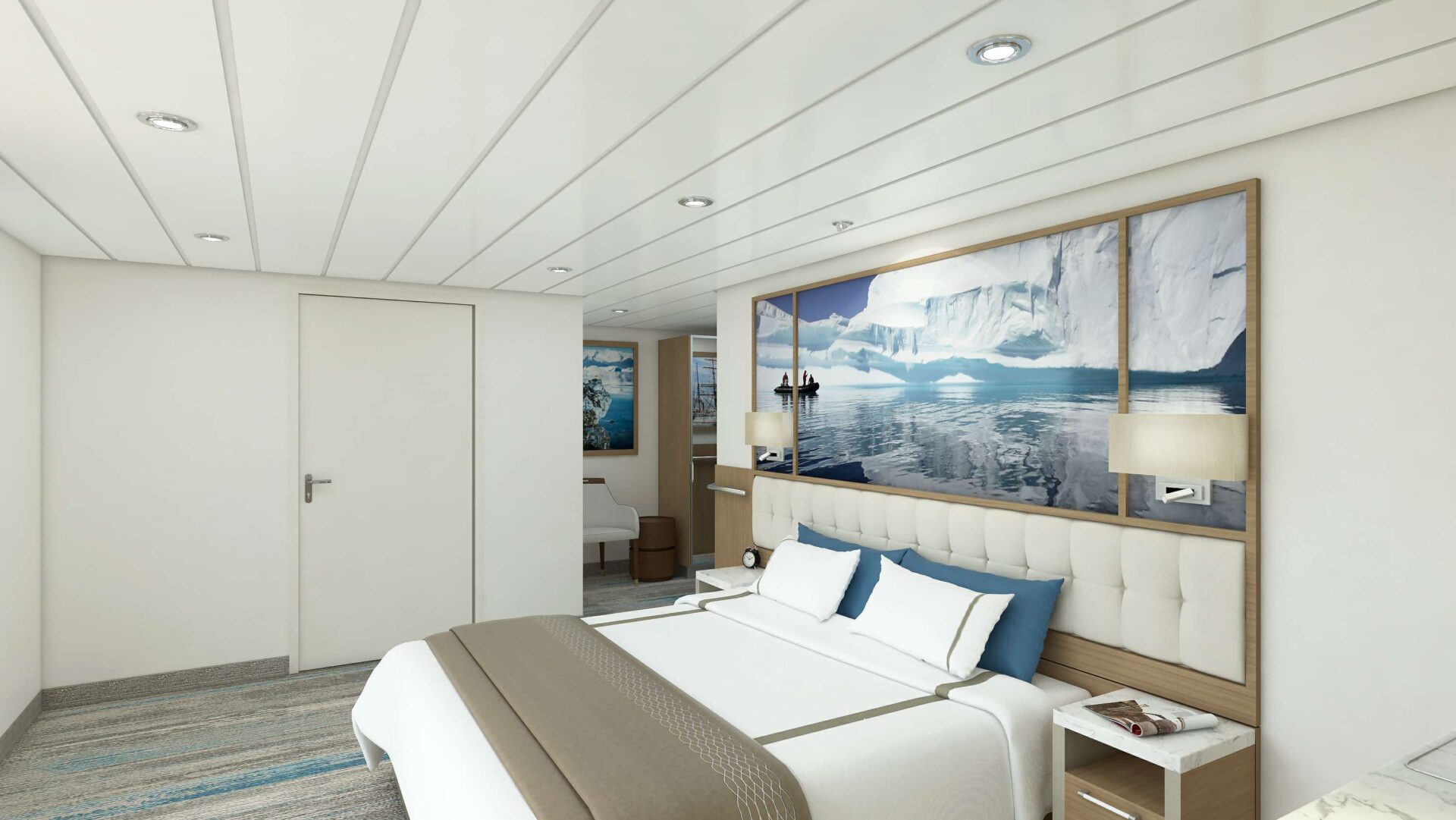
Balcony Stateroom Superior
Balcony Stateroom Superior
Deck: 4 & 6
Cabin and balcony combined size: 28.2m² - 40.2m² (303.54 ft² - 432.70 ft²)
King bed
Twin beds
Features
Private en-suite (wheelchair accessible)
Private balcony
Full size window
Desk area
Closet space
Room-controlled thermostat
Room safe
42" flat-screen TV
Mini bar*
Cabin Inclusion
- 1 x 3-in-1 polar jacket per person (polar voyages only)
Some of these rooms are equipped with wheelchair accessible bathrooms.
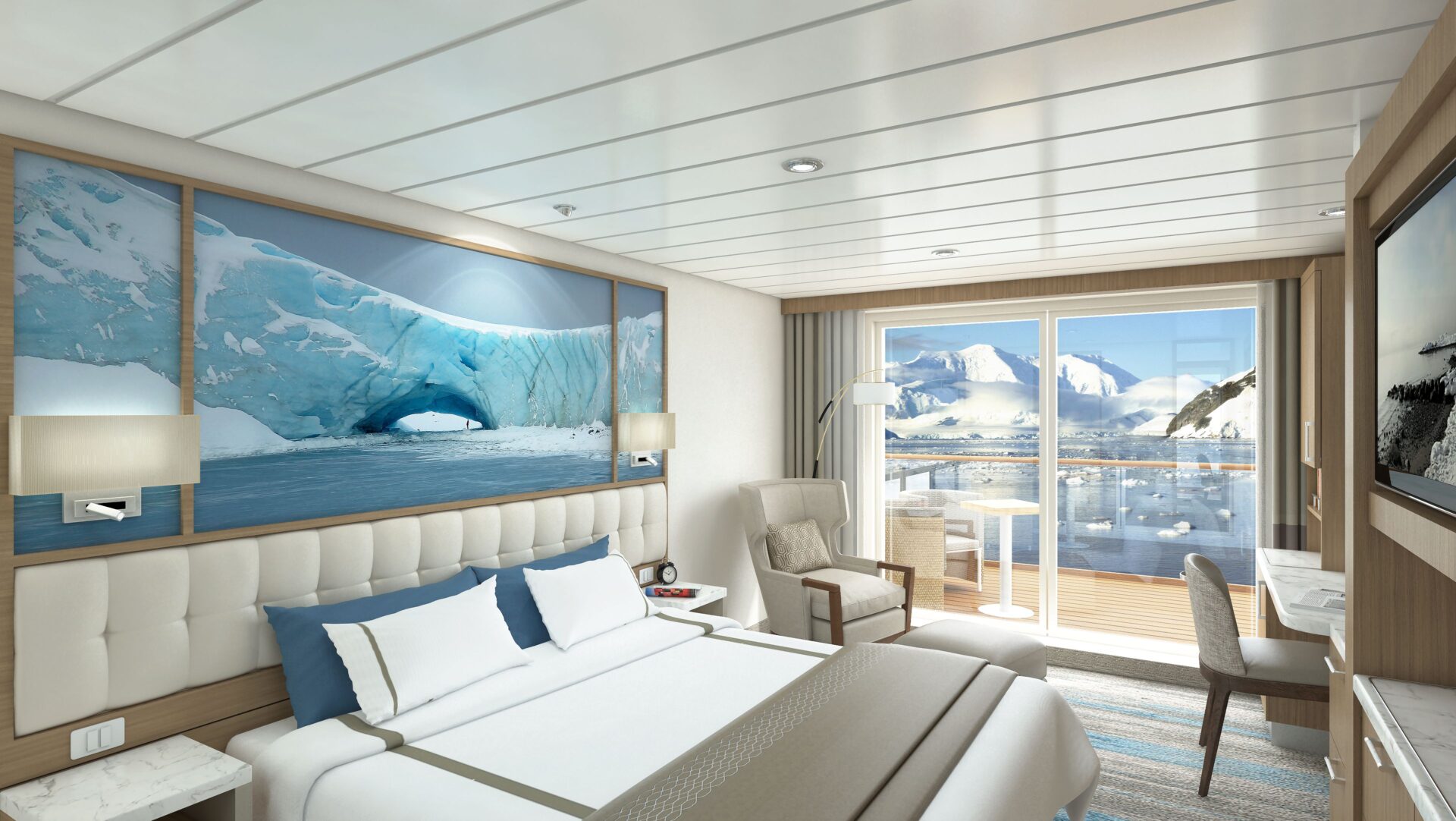
Junior Suite
Junior Suite
Deck: 7
Cabin and balcony combined size: 38.9m² (418.71 ft²)
King bed
Twin beds
Features
Private en-suite
Private balcony
Full size window
Separate lounge area
Desk area
Closet space
Room-controlled thermostat
Room safe
42" flat-screen TV
Mini bar
Cabin Inclusion
- 1 x 3-in-1 polar jacket per person (polar voyages only)
- 1 x free pair of binoculars per suite
- Free stocked mini bar^
- 1 x free bottle of champagne per suite
^Junior Suites stocked once only, not replenished. Captain’s Suite replenished as needed.
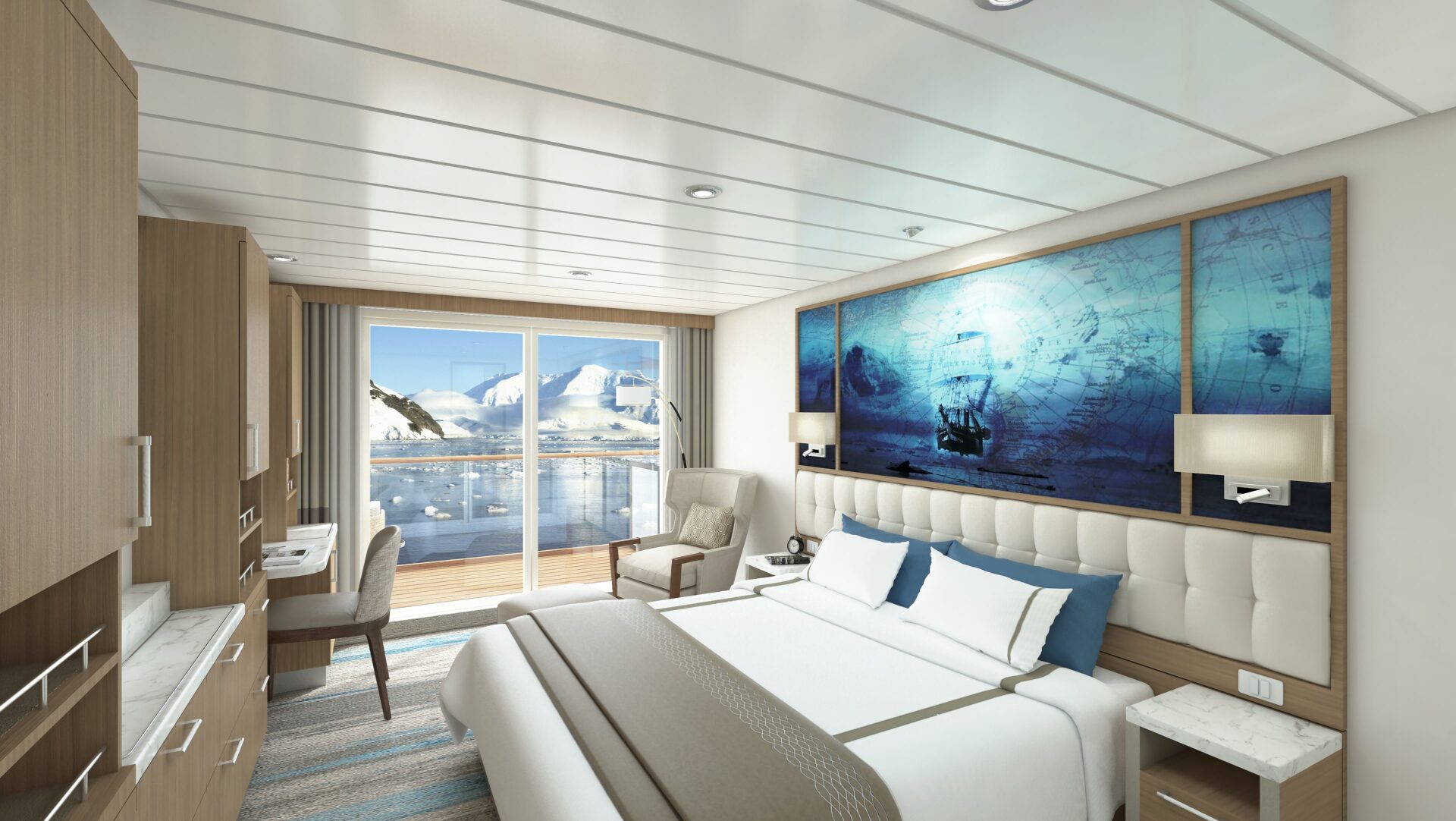
Captain’s Suite
Captain’s Suite
Deck: 4
Cabin and balcony combined size: 44.5m² (478.99 ft²)
King bed
Twin beds
Features
Private en-suite
Private balcony
Full size window
Separate lounge area
Desk area
Closet space
Room-controlled thermostat
Room safe
42" flat-screen TV
Mini bar
Cabin Inclusion
- 1 x 3-in-1 polar jacket per person (polar voyages only)
- 1 x free pair of binoculars per suite
- Free stocked mini bar^
- 1 x free bottle of champagne per suite
^Junior Suites stocked once only, not replenished. Captain’s Suite replenished as needed.
Some cabin images of the Greg Mortimer are artist’s impressions only and final results may vary.
Prefer a shorter voyage?
‘Northern Isles & Wilderness: Scotland & Iceland’ is a combination of the 12 day Wild Scotland & the 11 day Iceland: Encircling the Land of Fire and Ice. View these itineraries below or contact us for more information.
Wild Scotland
Discovery
Discover the wild isles of Scotland, from the windswept Hebrides, inhabited for over 8,000 years, to the verdant Orkney Islands, where ancient Neolithic and Viking sites conjure images of civilisations...
12 Days
From AUD $16,655.75/pp
Iceland: Circumnavigating the Land of Fire & Ice
Discovery
Welcome to Aurora Expeditions’ Iceland: Circumnavigating the Land of Fire & Ice expedition.Explore the ‘Land of Ice and Fire’ where snow-capped peaks rise above glaciers and active volcanoes rumble. Explore...
11-12 Days
From AUD $15,916.00/pp

